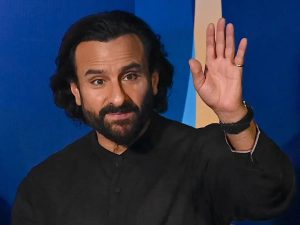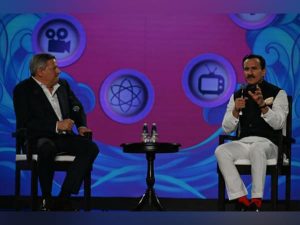How OTT Platforms in India Are Offering Global Recognition to Indian Talent Like Never Before
Bollywood actor Saif Ali Khan has praised the global reach that OTT platforms in India provide. Speaking at the World Audio Visual Entertainment Summit (WAVES) 2025, he shared that he now receives more recognition for his work on streaming platforms than from theatrical releases.
Khan explained that he receives calls from audiences in Europe and the U.S., a response he rarely got for his films. This global visibility allows Indian actors to be part of international conversations, comparisons, and appreciation.
His remarks underline a key reason why OTT platforms in India are seen as game-changers. They offer a worldwide audience without the restrictions and overheads of theatrical distribution. For actors, this opens the door to newer, more diverse audiences—and greater opportunities.
Also Read : Will the Public See Diddy’s Trial? Inside the Legal Battle and Media Access

The Shift From Boxed Roles to Creative Exploration: OTT Gives Indian Actors Room to Innovate
One of the biggest transformations OTT platforms in India have introduced is the creative liberty to break stereotypes. Saif Ali Khan emphasized that before streaming, actors were often forced into restrictive molds. There was a formula—how you looked, behaved, or even spoke, especially if the film was meant for commercial success.
Now, actors are no longer confined to fixed roles or “safe” character arcs. They can experiment with layered personalities, non-linear stories, and complex narratives. Khan referred to this as “the most liberating thing” to happen to the acting profession.
OTT content, especially in the form of series, allows for deeper storytelling. Characters can evolve over several episodes or seasons, giving writers and performers ample space to develop arcs that wouldn’t be possible in a 2-hour film.
Equality on Set: How OTT Platforms in India Are Reshaping Professional Dynamics Among Artists
Another strong point that Khan raised during his conversation with Netflix CEO Ted Sarandos was the professional equality that OTT work environments foster. On streaming projects, actors—regardless of their box office clout—are treated equally.
Khan cited Sacred Games, Netflix’s first original Indian series, as a clear example. On that set, the hierarchy was flattened. There were no “stars,” only collaborators. This encouraged better performance, more open communication, and stronger ensemble storytelling.
Such an approach is rare in traditional Bollywood productions where A-listers often get special treatment. OTT platforms in India are setting new standards that are reshaping how projects are executed—from casting to final cut.

Preserving Cultural Identity: Telling Authentic Indian Stories to a Global Audience Through OTT
While OTT platforms provide global exposure, Saif Ali Khan insists that preserving Indian cultural identity is key. When international viewers ask about his work, he proudly points them toward Omkara or Parineeta. These are stories rooted in Indian ethos, yet universally relatable.
OTT platforms in India are enabling the world to understand Indian culture through rich, well-told stories. It’s not just about crime thrillers or romantic comedies anymore. Now, themes like mythology, folklore, historical drama, and regional politics are being explored at depth.
This approach not only promotes India’s soft power but also offers filmmakers the opportunity to express genuine narratives without censorship or commercial pressure.
Streaming and Cinema Are Not Rivals: Why Both Mediums Can Thrive Together in the Indian Market
A common concern is whether OTT platforms in India will eventually replace cinemas. Both Saif Ali Khan and Ted Sarandos rejected this idea. According to them, streaming and theatres serve different needs but can coexist and even complement each other.
Khan acknowledged that some stories deserve the larger-than-life cinematic treatment. Epic dramas or action films work best on the big screen. On the other hand, slow-burn thrillers or character-driven narratives often perform better in digital formats.
This hybrid model can create a robust entertainment ecosystem. Films can have limited theatrical runs and then find a longer shelf life online. In this way, OTT becomes not a rival, but a reinforcement of cinema’s legacy.

WAVES 2025: India’s Growing Influence in the Global Entertainment and Audio-Visual Sector
The backdrop of Khan’s remarks was WAVES 2025—India’s first international summit focused on the audio-visual and entertainment sector. The summit brought together over 10,000 delegates, 1,000 creators, and representatives from 300 companies and 350 startups.
The event aims to foster collaboration across industries, from broadcasting to gaming to OTT platforms in India. With the rise of immersive technologies like AR, VR, and AI in storytelling, the Indian entertainment industry is entering a new era.
Platforms like Netflix, Amazon Prime, and Disney+ Hotstar are not just distributing global content—they’re sourcing and developing local content with global standards. That gives Indian talent like Saif Ali Khan a powerful stage to perform and innovate.
OTT Platforms in India Are Here to Stay: What This Means for the Future of Storytelling
There’s little doubt now that OTT platforms in India are not a passing trend. They are redefining entertainment norms by prioritizing talent, authenticity, and creativity over commercial metrics alone.
Actors can take on challenging roles. Directors can take creative risks. Audiences can access quality content across genres, languages, and formats. The creative economy stands to benefit enormously.
As Khan noted, the most exciting projects today aren’t just big-budget films. They’re deeply written, well-acted series and films that stream globally. This is storytelling for a new world—one that values content over clout.
Saif Ali Khan Champions the OTT Era as a Milestone in Indian Cinema’s Global Journey
Saif Ali Khan’s views are a reflection of how rapidly the entertainment landscape is evolving. With OTT platforms in India, actors have found a stage that offers both visibility and versatility.
His endorsement of streaming platforms isn’t just personal—it speaks to a broader industry shift that prioritizes creativity, inclusivity, and reach. As Indian stories find a global home online, the possibilities for storytelling, performance, and production are limitless.
The future of entertainment in India doesn’t lie in choosing between OTT and cinema—it lies in making space for both.

